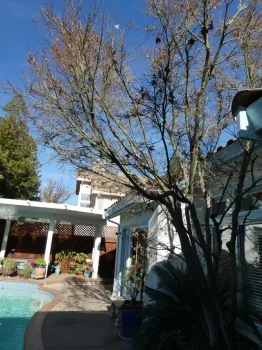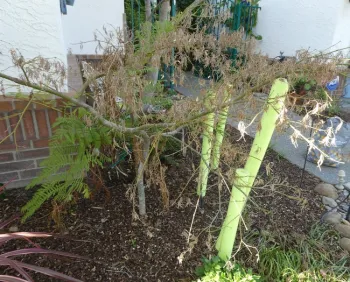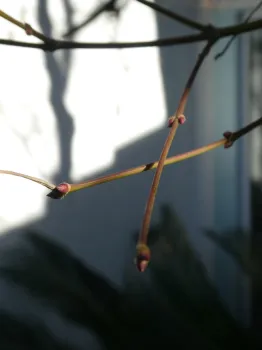Shaping the Maple
Scraggly, overgrown and definitely neglected — that's how I describe the two Japanese maple trees in my yard. Both the 3' weeping laceleaf in the front and the 10' upright in the back need pruning. But where do I begin?


In years past, I've tackled this task without consulting a certified arborist, learning from experience that a tree's shape can be destroyed by lopping off too many limbs. I've watched branches die back. But this time around what really gives me pause is the sight of a squared-off shrub outside my chiropractor's office. With each visit, I wince at the mutilated Japanese maple that was probably attacked by a rip-roar chainsaw or quick-draw hedge trimmer in the hurried hands of a “mow-blow-go” gardening service.
So I decided to move slowly. To step back from each tree and see its unique shape. To learn its needs from a “how best to grow a Japanese maple” point of view. Here are just two of the many tips I gleaned from my research:
Know the growing habit of your tree before you prune
There are over 300 varieties of Japanese maples—slow growers and fast growers; some with one trunk, others with multiple. Japanese maples range in height from 20 feet tall to dwarf at 5' or less. Their beauty is in their shape from weeping, cascading, mounding or horizontal branching trees to upright growers with rounded dome-shaped crowns. Your tree's natural growth habit is its greatest asset. That's why it's important to stop, look at your tree and know its shape before you dust off your pruners. In other words, walk around it and then step back and see the whole of it. Your objective is not to change the shape of your tree but to encourage its natural shape. For colorful photos of several varieties, check out “The Complete Japanese Maple Guide” at https://www.thetreecenter.com/complete-japanese-maple-guide/
There are over 300 varieties of Japanese maples—slow growers and fast growers; some with one trunk, others with multiple. Japanese maples range in height from 20 feet tall to dwarf at 5' or less. Their beauty is in their shape from weeping, cascading, mounding or horizontal branching trees to upright growers with rounded dome-shaped crowns. Your tree's natural growth habit is its greatest asset. That's why it's important to stop, look at your tree and know its shape before you dust off your pruners. In other words, walk around it and then step back and see the whole of it. Your objective is not to change the shape of your tree but to encourage its natural shape. For colorful photos of several varieties, check out “The Complete Japanese Maple Guide” at https://www.thetreecenter.com/complete-japanese-maple-guide/
Know when and where to tidy up versus serious pruning
Yearly pruning is rarely recommended for Japanese maples. However, tidying up the tree by clearing out the deadwood is vital. By cutting out these brittle twigs and dead branches, you open up the tree's interior space for light to penetrate and for air to circulate between branches. You'll know that a stem or branch is not deadwood if you see a bud. (See photo below) Also recommended is the removal of branches that rub against other limbs and branches that cross over the midline of the tree. The general rule is don't hack off more than the half the total mass of your tree. Experts say with a laceleaf maple try to create “a shell-like growth” that shields the trunk. Remember before you make any cut, ask what effect it could have on your tree. I found helpful information and illustrations on the following links: https://www.swansonsnursery.com/japanese-maple-pruning and http://www.gardenality.com/Articles/340/How-To-Info/Prunning/How-To-Prune-A-Japanese-Maple/default.html
Yearly pruning is rarely recommended for Japanese maples. However, tidying up the tree by clearing out the deadwood is vital. By cutting out these brittle twigs and dead branches, you open up the tree's interior space for light to penetrate and for air to circulate between branches. You'll know that a stem or branch is not deadwood if you see a bud. (See photo below) Also recommended is the removal of branches that rub against other limbs and branches that cross over the midline of the tree. The general rule is don't hack off more than the half the total mass of your tree. Experts say with a laceleaf maple try to create “a shell-like growth” that shields the trunk. Remember before you make any cut, ask what effect it could have on your tree. I found helpful information and illustrations on the following links: https://www.swansonsnursery.com/japanese-maple-pruning and http://www.gardenality.com/Articles/340/How-To-Info/Prunning/How-To-Prune-A-Japanese-Maple/default.html

